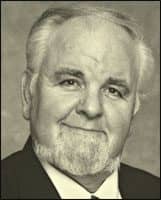Donald Norman, founding Chair of the Dept. of Cognitive Sciences at UC-San Diego, has written extensively about the need for “human-centered technology.”1 Norman rather harshly observes that “machine-centered technology that is intended to aid human cognition and enjoyment more often interferes and confuses than aids and clarifies.” With this in mind, the listener-centered design of A-Life® 9000, discussed in this article, is specifically organized to accomplish a clarification process2, and designed to assist rather than to interfere in the fitting of hearing instruments.
Part 1 of this article3 explained the rationale and motivation behind the system’s development by Geers Hörakustik in Dortmund, Germany. The concept of an “Auditory Life” was introduced in conjunction with the continuing challenge of matching the vast array of new audio technologies to the personal preferences and desires of hearing-impaired consumers. The rationale for implementing fuzzy-logic procedures was also discussed.
In the present article, greater detail will be given to the psychoacoustic model, the operation of the A-Life® 9000 procedure, some samples of research on the procedure and the current status of utilization in various places around the world. The multi-dimensional HearNet® profile of acoustical impression will also be described.
Structured Fine-Tuning
As indicated in Part 1, the concept of “fine tuning” is often mistaken to mean “easy and insignificant.” However, in truth, the fine-tuning of complex instruments to subjectively acceptable alignments is anything but trivial in both consequence and in resulting operation.2 The process of fine-tuning a hearing system with natural acoustic signals (versus traditional narrowband, non-meaningful signals) clearly constitutes an even more complex problem. The system detailed in this technical report methodically approaches this complex problem with the help of a special software algorithm.
As noted in previous work, the task of optimizing a hearing instrument fitting is well-suited for a fuzzy logic treatment.4,5 The fuzzy logic algorithms developed for this system attempt to use methods closely allied to human thought (see Part 1 of this article on the HR website for more information).
“Naturalness” & “Acoustical Satisfaction”
Summarizing fitting results from the perspective of the hearing instrument consumer is important. Traditionally, audiological descriptions are used as a means of verifying the success of a fitting. But these data may not directly reflect the consumer’s subjective impression. There is no guarantee that a 20% improvement of speech understanding on clinical material coincides with the client’s real-life experience of a speech understanding improvement of 20%. The A-Life fuzzy-logic model is designed to allow for the calculation of such combined quantities and the expression of the result for the individual customer.
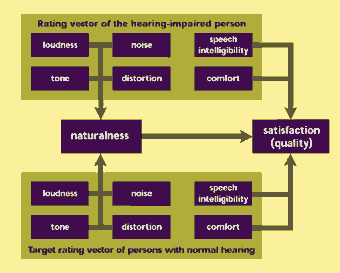
The description of the fitting’s performance results are expressed in two ways. The first quantity is named “naturalness,” which is defined as a general equivalence for the hearing-impaired listener’s impression of loudness, tone, noise and distortion with normal-hearing impressions for the same sound patterns. This is illustrated in Fig. 1 where the naturalness dimension is shown as a derivative of the loudness, tone, noise and distortion values. However, it cannot be assumed that alignment by otopathologic listeners on these perceptual features with normal-hearing listeners will necessarily result in judgments of high sound quality.
For this reason a second quantity is defined in an attempt to characterize acoustical “satisfaction.” High satisfaction, in this model, is assumed to consist of a high degree of perceived speech intelligibility and a high degree of comfort. The results of naturalness and satisfaction are consequently expressed in terms of the customer’s direct listening experience with the particular fitting.
The Optimizing Procedure
The A-Life procedure consists of three successive elements that include the Multimedia Profile Analysis; the Multimedia Profile Design, and the Multimedia Profile Service.
The starting point is the Multimedia Profile Analysis. The main components of the profile analysis are:
• Analysis of problems;
• Measurement of degree of hearing impairment;
• Definition of benefit;
• Demonstration of features
The analysis of problems covers the acoustic environment of the client, including his/her ideas and wishes for improved hearing. The delineation of the client’s hearing limitations is clearly an important part of the hearing solution. It reaches full expression in the correlation of the auditory impairment to the options of modern hearing systems.
Measurement methods to profile the clinical hearing impairment are primarily pure tone and speech audiometrics. Tympanometry and stapedial reflex measures are also useful in characterizing the hearing pattern. Of course, loudness scaling is also available to the professional for describing the patient’s dynamic range.
The determination of the perceived hearing problems and wishes can be done by an interview supported by questionnaires or sound environment demonstrations. Software-based tools are used to guide the professional through the process and extract the most important information from the client.
After completing the analysis of the problems and the measurement of the hearing loss, the starting point of the limited quality of hearing is defined. This process also helps to clarify for the patient the best achievable final sound quality. In other words, realistic expectations are counseled on the basis of the existing data and the client’s indication of price limitations as per the available choices of hearing instrument systems. With full allowance for all of these considerations, the Multimedia Profile Design is then commenced.
The results of the audiological examinations and the data from the customer interview define the basis for the pre-selection and fine-tuning of the hearing systems. Taking into account further features of the hearing system, the computer program and the professional determine the transmission characteristic.
A separate optimization is carried out for each sound pattern program. This consists of a series of fitting stages. Each stage proceeds from a predetermined hearing instrument setting. The client’s rating of the hearing impression based on hearing dimensions (loudness, tone, etc.) is used to obtain alteration criteria which serve as a starting point for optimizing the settings. The listener enters his/her rating on a touch screen/pad on which the hearing dimensions and verbal categories are displayed (an example can be seen on p. 48 of the Sept. 2000 HR). The acoustic pattern is repeated until a result has been obtained for each hearing dimension.
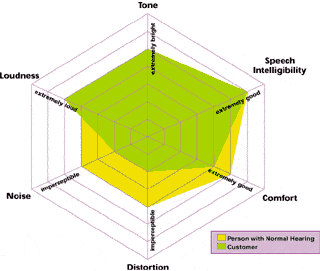
The overall results of the rating procedure is indicated to the professional as a “HearNet” (Fig. 2). The axes of the net represent the hearing dimensions to be rated. The ratings are depicted as an area which is formed by connecting the assessment points on the axes. In addition to the individual “assessment area,” the results of the ratings for normal-hearing
people are indicated for the appropriate acoustic pattern groups.
This manner of presentation accomplishes three important objectives. First, it guarantees that an overall view of the optimization results is achieved. Secondly, it provides an appropriate view of how normal-hearing listeners assess these same features. Finally, it allows for the identification of distances to the optimization target for each individual case. Suggestions for alterations are calculated from these results. The professional then carries out the appropriate modifications to the hearing system, or in the case of certain digital hearing instruments, the software automatically makes the adjustments.
The selection of different hearing instruments often forces the hearing care professional to jump between different protocols, setting approaches and processes. The A-Life approach is designed to remedy this. The accuracy of the setting is strongly dependent on the subjective responses of the client. With standard approaches, long hearing instrument fitting times often occur, resulting in the patient becoming overwhelmed and/or distracted by the procedure. Simultaneously, the fitter can be forced to make guesses as to the appropriate adjustments in order to shorten the process. Deviations from the “optimum” setting are often “counseled away” in a kind of YGUTI (“You’ll get used to it”) method of expediency.
To focus on the subjective process, it is important to reduce this stress and time expenditure through automated procedures. The know-how of professionals and manufacturers can be merged, and complex information regarding settings can be exchanged. (For details on the processing and formulas used by the software, the reader is referred to the Geers website at http://www.geers.de.)
If the adjusted hearing system transmission pattern is accepted by the listener, and if there is sufficient coverage of the Hear Net area for the listener relative to the normal-hearing pattern, then the fine tuning of the hearing program can be ended. The final display records the result of the optimization. By means of the interaction between recommendation and effect, the hearing-program setting is adapted to the individual’s “optimum” use within a reasonable period of time, typically 25 minutes.
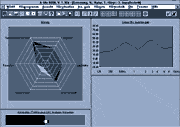
The expression of results via a HearNet and a separate calculation of naturalness and quality based on acoustical parameters provide an objective outcome for an obviously subjective experience of auditory life. In every fitting stage, and especially at the end of the process, the quality can be compared with the verbally expressed quality impression of the client. Hence, a kind of quality control and tracking option is fulfilled. Furthermore, the HearNet and the quality parameter can be used to demonstrate to the consumer the improvement of quality as part of the counseling process. A sample of the monitoring screen is shown in Fig. 3.
The active involvement of the client in the configuration and tuning of his/her hearing system is designed to provide an enriched personal communication strategy. Such a communication strategy is useful in counseling, the rendering of ongoing services, the generation of additional customer profile scenarios and the integration of sales tools.
Validation Studies
Field Study: A field study was conducted over a nine month period involving 128 potential customers who were fitted by the A-Life system.5,6 Sixty-two percent of the subjects had previous experience with hearing instruments, while 38% were inexperienced users. Thirty-four percent were binaural hearing instrument users and 66% were monaural.
Efficiency of an adjustment process can be estimated by the number of necessary fitting stages (i.e., the number of stages is generally inverse to the process, as well as the skill and experience of the hearing care professional). It is also influenced by the accuracy of the proposed settings and the manual transfer of the setting information into the hearing instrument. For all subjects and for all sound pattern groups, a significant difference in the numbers of fitting stages was determined. Sixty-five percent of the inexperienced test subjects required between two and three stages. For 14%, only one fitting stage was necessary, and for another 14% four stages were required. The main reasons cited for the higher numbers were the degree of difficulty of the sound environment or the individual facility with the rating task. For experienced users, the number of fine-tuning fitting stages was less: 36% of these subjects needed one fitting stage, 18% two, 32% three and 14% four. No instances of more than four fitting stages were observed.

An additional criterion of the field test was the determination of the sensitivity of the hearing dimensions for setting changes. The sensitivity is different for all hearing dimensions. Fig. 4 shows the distribution for loudness for the sound example, “Home-sphere” with a sample size of 34 subjects. In the unaided condition, the test subjects rated the sounds as “extremely quiet” or “very quiet.” For the pre-setting (first fitting stage) condition, the judgments changed to “quiet” (14 subjects) and “medium” (18 subjects) ratings. However, the “normal hearing” rating for this sound example is “medium.” At the end of the fine tuning, 24 subjects achieved the normal-hearing category “medium”, two rated the sound sample as “quiet” and eight rated it as "loud". This shows that the interactive approach resulted in a substantial movement towards the normal hearing ratings.
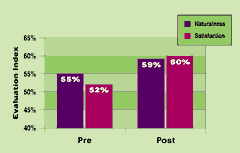
Fig. 5 demonstrates the average improvement for a single fitting stage of the calculated quantities “naturalness” and “satisfaction.” In terms of rated categories it could be interpreted that, for the main dimensions per fitting stage, a minimal improvement of one category could be attained.
Questionnaire study: In a second study, the results of these fittings were compared with results of Geers hearing care professionals who were not using the A-Life approach. This information was available from a study conducted at the Univ. of Würzburg on behalf of a German insurance company. A sub-set of the Würzburg questionnaire inventory7 was used to study the A-Life procedure. In the Würzburg study, 674 individual questionnaire responses were evaluated, and the subjects were fitted with hearing instruments from 1989-1994.
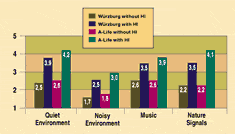
The study used a sample size of 67 test subjects fit using the A-Life procedure. Fig. 6 shows consistently higher ratings were observed for these fittings. Advantages for using the system can be seen for both quiet and noisy environments. Improvements are also evident for music and natural signals. Information that would have permitted classification of results
of the Würzburg study according to the kind of fitting and to the type of the hearing instrument was, unfortunately, not available.
Status & Availability of System
The system was developed as a NOAH 2.0 module, and initially put into use in 1996. Subsequently, a NOAH 3.0 version has been developed for introduction in the second half of 2000. At present, the interactive dialogues and sound samples have been prepared and calibrated in only German and Italian.
The system has been used in over 80 dispensing facilities in Germany since 1996. The additional release of an Italian version in 1997 has resulted in the use of the A-Life fitting system on over 45,000 hearing instrument consumers as of mid-1999. Since its introduction, many inquiries as to the use and deployment of the system in other countries have been received, and preparatory work on an English version is currently scheduled.
Technical improvements under development presently include a binaural version that will allow optimization for localization and hearing of signals in noise. Also, greater attention to multiple input levels will be included in the forthcoming versions. This will better address the dynamic setting possibilities of advanced hearing aids. Additionally, increased options for the software module, such as making use of sound cards and monitor changes are being considered.
Summary
Returning to the comments of Donald Norman2, the measurement tools of science, by design, try to strip away the complexities of human experience to study “a single variable at a time.” But, he observes, “much of what is of value to human life results from the interaction of the parts: when we measure simple, single variables, we miss the point.” Those comments are fundamentally consistent with the motivation behind the Geers system. Integrating rigorous scientific procedures with natural sound samples and investing in the trustworthiness of the consumer’s subjective opinion are central.
The A-Life® 9000 approach is intended to reduce the multiple uncertainties of modern hearing instrument fittings by providing a means for listeners to direct the fine-tuning process. The system reproduces the important acoustical properties of the consumer’s hearing environment as disclosed in an interview process. Subjective perceptions of listeners are described and detailed in six quantified hearing dimensions represented in a HearNet pattern which is re-shaped towards normal listener patterns during the interactive fitting process. Multiple-memory hearing aids can be optimized for different sound pattern groups.
Application of the algorithm, which incorporates the customer’s interactive judgements, results in a suggested alteration of the hearing aid setting. In advanced digital hearing instruments, the software can directly make these changes. In programmable or conventional instruments, the dispensing professional is guided as to the changes suggested by the listener’s judgments.
The course of engineering and technical progress in hearing instruments will no doubt continue through the present decade and beyond. However, it is hard to imagine how the direct and immediate subjective impression of the end user will ever diminish in importance. Processes that systematically seek to integrate those impressions into the final fitting can arguably reduce the uncertainties of configuring the ever-more complex audio processing schemes available to consumers and hearing care professionals.
This article was submitted to HR by Jörg Haubold, director of research and engineering at Geers Hörakustic, Dortmund, Germany, and Christopher Schweitzer, PhD, director of Hear4-U Intl. and senior audiologist at Family Hearing Centers, Lafayette, CO. Correspondence can be addressed to HR or Christopher Schweitzer, PhD, Hear4-U Intl., 2505 Ginny Way, Lafayette, CO 80026; email: Haubold at [email protected] or Schweitzer at [email protected] .
References
1. Norman D:. Things That Make Us Smart: Defending Human Attributes in the Age of the Machine. Reading, MA: Addison-Wesley, 1993.
2. Schweitzer C & Haubold J: Closing the gaps on hearing aid acoustical satisfaction. Audiol Today 2000; 12 (1): 18-19.
3. Haubold J & Schweitzer C: Fitting for an "Auditory Life." Hear Review 2000; 7 (9): 42-51, 76.
4. Haubold J & Schmalfuss G: Psychoacoustic based hearing aid fitting with complex acoustic signals. Poster presentation at the NIDCD/VA Hearing Aid Conference, Bethesda, MD, 1997.
5. Haubold J & Schmalfuss G: Anwendung psychoakustischer Verfahren zur Optimierung von Hörgeräteeninstellungen. Poster presentation at the DGA 1998: Oldenburg, 1998.
6. Haubold J, Müldner M: Fragebodenstudie zur Versorgungs qualität unterschierdlicher Hörgeräeanpasskonzepte. DGA 1999: Munich, 1999.
7. Stock A, Fichtl E, Knoblach W, Boretzki M & Heller O: Über das Tragen von Hörhilfen—Ergebnisse einer epidemologischen Studie. Würzburg, Germany: Forschungsbericht des Instituts für Psychologie der Julius-Maximilians-Universität-Würzburg, Bericht Nr. 4, 1999.

